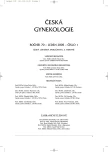MMP-26 mRNA and Estrogen Receptor Alpha Co-expression in Normal and Pathological Endometrium
Authors:
R. Pilka 1,3; Milan Kudela 1; P. Eriksson 2; B. Casslén 3
Authors‘ workplace:
Gynekologicko porodnická klinika, FN a LF UP, Olomouc
přednosta prof. MUDr. M. Kudela, CSc.
1; Oddělení výzkumu arteriosklerózy, Výzkumný ústav Krále Gustava V, Nemocnice Karolinska, Stockholm, Švédsko
2; Gynekologicko porodnická klinika a Biomedicínské centrum, Univerzita v Lundu, Švédsko
3
Published in:
Ceska Gynekol 2005; 70(1): 56-62
Category:
Original Article
Overview
Objective:
To examine the expression pattern of matrix metalloproteinase-26 (MMP-26) mRNAand estrogen receptor-alpha (ER alpha) in normal, hyperplastic, premalignant and malignant endometrial tissue.
Design:
Experimental study.
Setting:
Department of Obstetrics and Gynecology of the Palacky University Medical School and University Hospital, Olomouc, Czech Republic, Department of Obstetrics and Gynecology, University Hospital, Lund, Sweden, Atherosclerosis Research Unit, King Gustav V Research Institute, Karolinska Hospital, Stockholm, Sweden.
Methods:
We studied MMP-26 mRNA and ER alpha in 36 normal, 7 hyperplastic, 6 premalignant and 19 malignant endometrial samples. Based on histological examination, all normal specimens were classified acccording to an ideal 28 day menstrual cycle as early, mid, and late proliferative phase, early, mid and late secretory phase and menstrual phase. Samples with hyperplasia were classified as simple or complex. Premalignant samples were represented by complex hyperplasia with atypia. Malignant samples were histologically classified as well, intermediately and poorly differentiated, respectively. Specimens were analyzed using in situ hybridization and real time PCR. ER alpha was localized by immunohistochemistry.
Results:
Epithelial MMP-26mRNA expression was highest in the early secretory phase and in endometrial hyperplasia. Expression levels were low in the late secretory and menstrual phase and in malignant samples decreased gradually with dedifferentiation. Expression pattern of MMP-26 mRNA in normal, hyperplastic, premalignant and malignant endometrial tissue strongly co-variated with that of ER alpha.
Conclusion:
Co-expression of MMP-26 and ER alpha in normal and pathological endometrial tissue suggests possible regulation of MMP-26 gene by estrogen.
Key words:
endometrium, MMP-26, mRNA, regulation, ER
Labels
Paediatric gynaecology Gynaecology and obstetrics Reproduction medicineArticle was published in
Czech Gynaecology

2005 Issue 1
Most read in this issue
- Abdominal hysterectomy – Risk Factor in Development of Urinary Incontinence? Results of a Questionnaire Study
- Risk Factors of the 3rd and 4th Degree Tear during Delivery
- Syndrome of Pseudomyxoma Peritonei – Description of Three Cases and Survey of the Problem
- Contribution of Doppler Examination in Pregnancy at Risk of Alloimune Fetus Anemia
